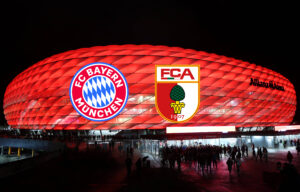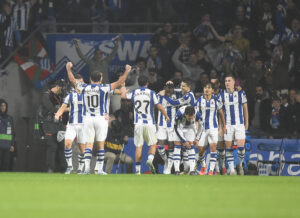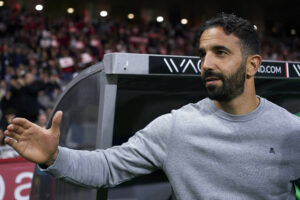Uruguay’s memorable run to the 2010 World Cup semi-finals was led by striker Diego Forlán’s brilliance. Although Óscar Tabárez’s squad boasted other talents, like captain Diego Lugano and a young Luis Suárez, the squad this year should be much deeper. With this in mind, do La Celeste have the capability to make an impressive challenge in Russia?
Goalkeeper
Fernando Muslera was in goal in 2010, and will start in between the sticks once again in Russia 2018. He’d had 6 appearances for Uruguay prior to the 2010 tournament, but is now up to 96.
He will also be entering Russia as a full-time club starter for Süper Lig leaders Galatasaray. In 2010 he was playing second fiddle to Federico Marchetti at Lazio in the Italian Serie A, but that did not stop him from turning heads.
Muslera kept a clean sheet throughout the group stages for 2010, and had the longest clean sheet streak in the competition. Furthermore, he was instrumental in Uruguay’s quarter-final victory over Ghana by saving two penalties.
Muslera has continued his form with Galatasaray this season. To date, he has kept 10 clean sheets and averages a very solid 2.2 saves per game. He also performed admirably in CONMEBOL qualifying, allowing La Celeste to keep a positive goal difference of +12.
Successful footballing nations tend to have a reliable and experienced shot-stopper, and Uruguay have their own in Muslera.
Defence
Uruguay have no concerns with their central defence. In fact, they have arguably the top centre-back pairing in South America. Diego Godín, the team’s captain, and Jose Giménez both ply their trade for Atlético Madrid, and will bring their effective partnership to Russia.
At the age of 32, Godín has yet to see a decline. This season he has averaged nearly two interceptions and 4.6 clearances per game, boasting a passing percentage of 86.8.
The young Giménez has averaged 1.7 tackles and 4.5 clearances per game with a passing percentage of 81.3. Both will bring the grit and tenacity from their club to country this summer.
The full-back position sees a drop-off for La Celeste.
Maxi Pereira has been a steady force for years, and leads Uruguay in appearances with 124. He also has an impressive club career, playing for Portuguese powerhouses Benfica and Porto.
This season, however, now 33, age has caught up with him. He has only amassed 10 league appearances for Porto. His experience and leadership will be vital, but he may struggle to keep pace with various young wingers in Uruguay’s group. Most notably Mohamed Salah.
Guillermo Varela was viewed as a prospect at one time, making a couple appearances for Manchester United. In 2017, he transferred back to the Primera División in Uruguay for Peñarol. However, his short stature and thin frame may expose him throughout this tournament.
Martín Cáceres is another option for La Celeste. Although he has been mistake-prone in the past, he has a strong club résumé. His experience for clubs like Barcelona, Sevilla, Juventus, and Lazio should earn him as a first eleven spot. Cáceres also has an impressive knack for goal as a defender.
Midfield
A weak spot for La Celeste in the past, the team now has a plethora of options for the midfield. Although only recently making his first appearances, Lucas Torreira has been a force in club play for Sampdoria in Italy.
Not only is he a brutal defensive force, Torreira has a rocket of a foot and excels in finding available teammates. He struggles in aerial duels due to his height, but his tenacity makes up for it.
Matías Vecino is another star in Uruguay’s midfield, currently playing for Italian powerhouse Inter Milan. Vecino spends most of his time as a defensive midfielder, but is also reliable on the ball. Opponents find it tough to dispossess him, and is a master passer currently completing 88 percent of his pass attempts.
Rodrigo Bentancur, Diego Laxalt, and Gastón Ramírez are three other great options Uruguay manager Óscar Tabárez must decide between. They’re all Italian Serie A defenders who have impressed this season.
Bentancor has worked his way up the Juventus pecking order. Laxalt has shown his promising versatility for Genoa, and Ramírez has already appeared in 43 matches for Uruguay in his career.
Attack
Uruguay’s attacking force has never been in question. They have two of the most elite strikers in the world in their ranks, Edinson Cavani and Luis Suárez.
Cavani leads the line for French powerhouse PSG. He is also having one of his best seasons to date, with 36 goals in 44 appearances. He also lead CONMEBOL qualifying with a tally of 10 goals. Cavani has failed to leave a lasting mark in past World Cups, so will be looking to Russia to add more accolades to his impressive career.
Suárez, like Cavani, is enjoying another phenomenal season. He has scored 27 goals in 43 appearances for Barcelona thus far. He also contributed five goals in Uruguay’s qualifying campaign.
Although he’s an excellent finisher like Cavani, Suárez also has an uncanny ability to create space for his teammates. Key passing and accurate through balls in are two skills that allow him to thrive alongside a lethal poacher like Cavani.
Uruguay has one of the strongest attacks in all of world football. Although their depth in this area is questionable, Cavani and Suárez are a nightmare match-up for defenders.
The Last Word
Uruguay will be sending a very well balanced team to Russia this summer. With a relatively manageable opening group compared to others, Uruguay can impress early and have fans reminiscing about 2010.
The team has a combination of experience, youngsters, and superstars, giving them all the tools needed to make another deep run. A run which could lead them to the elusive Jules Rimay prize.
Luis Suarez has made a name scoring goals, but it was a famous SAVE that helped Uruguay advance to the semifinals of the 2010 FIFA World Cup.
The *other* hand of God comes in at No. 5️⃣5️⃣ in our #100Moments countdown. pic.twitter.com/YGjnkxTQT4
— FOX Soccer (@FOXSoccer) April 20, 2018






